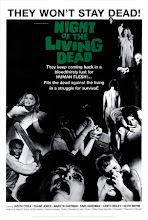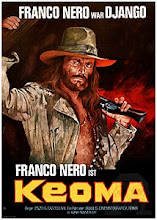Wednesday, March 27, 2013
THE SEARCH FOR WENG WENG: Kickstarter Week #2 update!
Wednesday, October 17, 2012
End Of The Wicked (1999) NEVER BROADCAST
 |
| Helen Ukpabio in mid-protestation |
 Which brings us to End Of The Wicked, a foaming-at-the-mouth
diatribe against the presence of demons and witches in our midst. Watching the
procession of the damned is Beelzebub himself, white faced with a vivid crimson
Van Dyke, sitting on his Evil Throne surrounded by shape-shifting crones.
"Dance the seduction dance!" he booms, trying to get the party
started. "The most sexy dance on Earth!" The ignomies pile up - in
the Torture Department a damned man's eyeballs pop out of his head and swing on
the end of stalks. One witch has possessed the wife of another doomed villager,
then shapeshifts into his mother, grows a ten inch penis and rapes the sleeping
wife. The village children too are taken from their beds and dragged to
Beelzebub's throne to do his bidding - See? It's all the proof you need that
children are EVIL!!! But still, Beelzebub is never satisfied, and like the CEO
of Qantas, keeps screaming "We must increase our wickedness!"
Which brings us to End Of The Wicked, a foaming-at-the-mouth
diatribe against the presence of demons and witches in our midst. Watching the
procession of the damned is Beelzebub himself, white faced with a vivid crimson
Van Dyke, sitting on his Evil Throne surrounded by shape-shifting crones.
"Dance the seduction dance!" he booms, trying to get the party
started. "The most sexy dance on Earth!" The ignomies pile up - in
the Torture Department a damned man's eyeballs pop out of his head and swing on
the end of stalks. One witch has possessed the wife of another doomed villager,
then shapeshifts into his mother, grows a ten inch penis and rapes the sleeping
wife. The village children too are taken from their beds and dragged to
Beelzebub's throne to do his bidding - See? It's all the proof you need that
children are EVIL!!! But still, Beelzebub is never satisfied, and like the CEO
of Qantas, keeps screaming "We must increase our wickedness!" We've played several Nigerian Godsploitation films before on
Schlock Treatment, so regular viewers will be prepared. For the Nollywood
novice: only God will save you from the yelled dialogue in quasi-English, the
garish home computer effects, and the hateful breath of fundamentalist
Christianity fogging up every minute of its litany of horrors. At the centre of
End Of The Wicked is Ukpabio herself, wielding her Sword of Righteousness
against the infant armies of Beelzebub in one hand and clutching a mountain of
"Get Out Of Hell Free" cards in the other. Back in the real world,
each time Ukpabio is investigated she cries religious persecution or plays the
racism card. But the statistics speak for themselves - from the late Nineties,
there are believed to be over 2000 deaths in Nigeria
alone, and many more in other parts of Africa.
Liberty is not the only church to squarely lay the blame; exorcising witch
children is big business, and despite laws prohibiting the torture and
execution of Witch Children, the African landscape remains dotted with 21st
Century Matthew Hopkins, the smoke from charred infants swirling around their
feet. And with that imagine firmly implanted in your brains, I sentence you to
the Torture Department to watch End Of The Wicked.
We've played several Nigerian Godsploitation films before on
Schlock Treatment, so regular viewers will be prepared. For the Nollywood
novice: only God will save you from the yelled dialogue in quasi-English, the
garish home computer effects, and the hateful breath of fundamentalist
Christianity fogging up every minute of its litany of horrors. At the centre of
End Of The Wicked is Ukpabio herself, wielding her Sword of Righteousness
against the infant armies of Beelzebub in one hand and clutching a mountain of
"Get Out Of Hell Free" cards in the other. Back in the real world,
each time Ukpabio is investigated she cries religious persecution or plays the
racism card. But the statistics speak for themselves - from the late Nineties,
there are believed to be over 2000 deaths in Nigeria
alone, and many more in other parts of Africa.
Liberty is not the only church to squarely lay the blame; exorcising witch
children is big business, and despite laws prohibiting the torture and
execution of Witch Children, the African landscape remains dotted with 21st
Century Matthew Hopkins, the smoke from charred infants swirling around their
feet. And with that imagine firmly implanted in your brains, I sentence you to
the Torture Department to watch End Of The Wicked.
Commando (1988) NEVER BROADCAST
Avenging Woman Warrior 2 (1991) NEVER BROADCAST
 In the Seventies, Mexican pulp cinema took a turn down a
dirt road and left the masked mexican wrestlers and silver-suited alien women
behind. Dubbed "Narco Cinema", the films were cheaper, nastier tales
torn from tabloid headlines: of cocaine barons and vigilantes, of police raids
on crack dens and Robin Hoods of the drug-ravaged wastelands. One early Narco
classic was Lola La Traiera, or "Lola The Trucker", from 1983, in which the
daughter of a trucker gunned down by a drug cartel takes her revenge. Lola had
long legs, big hair, big wheels, and that smoking Latino sensuality, and turned
former soap actress Rosa Gloria Chagoyan into a bona fide ass-kicking icon of
South-of-ze-Border action films. Lola reportedly became the biggest grossing
Mexican film to date, and started a trucker craze which, not surprisingly
included several more Lola sequels starring Rosa Gloria.
In the Seventies, Mexican pulp cinema took a turn down a
dirt road and left the masked mexican wrestlers and silver-suited alien women
behind. Dubbed "Narco Cinema", the films were cheaper, nastier tales
torn from tabloid headlines: of cocaine barons and vigilantes, of police raids
on crack dens and Robin Hoods of the drug-ravaged wastelands. One early Narco
classic was Lola La Traiera, or "Lola The Trucker", from 1983, in which the
daughter of a trucker gunned down by a drug cartel takes her revenge. Lola had
long legs, big hair, big wheels, and that smoking Latino sensuality, and turned
former soap actress Rosa Gloria Chagoyan into a bona fide ass-kicking icon of
South-of-ze-Border action films. Lola reportedly became the biggest grossing
Mexican film to date, and started a trucker craze which, not surprisingly
included several more Lola sequels starring Rosa Gloria. Lola wasn't her only successful franchise. Avenging Warrior
Woman from 1988 struck a similar chord with Mexican audiences, featuring Rosa
Gloria as Ana Rosa, a kind of Charles Bronson/Sidney Poiter hybrid: high school
teacher by day, weapon-toting vigilante by night, and aided by her omnipresent
dwarf butler Reintegro, or "Refund". In the first film she takes on
another drug cartel and wins, leaving their boss in a wheelchair; in the second
film our heroine has amped up the odds and her weapon's store, and in a triumph
of cinematic chutzpah, thwarts a bank robbery on her motorbike equipped with
triple-barrelled machine guns. Voom! Right through a plate glass window, white
jumpsuit dazzling and barrels a-blazing.
Lola wasn't her only successful franchise. Avenging Warrior
Woman from 1988 struck a similar chord with Mexican audiences, featuring Rosa
Gloria as Ana Rosa, a kind of Charles Bronson/Sidney Poiter hybrid: high school
teacher by day, weapon-toting vigilante by night, and aided by her omnipresent
dwarf butler Reintegro, or "Refund". In the first film she takes on
another drug cartel and wins, leaving their boss in a wheelchair; in the second
film our heroine has amped up the odds and her weapon's store, and in a triumph
of cinematic chutzpah, thwarts a bank robbery on her motorbike equipped with
triple-barrelled machine guns. Voom! Right through a plate glass window, white
jumpsuit dazzling and barrels a-blazing.  She then goes deep undercover to find El Pregno's killers.
The cartel then kidnaps a nosy Senator's daughter and has the police department
in a frenzy, but not Avenging Warrior Woman, who smells the work of her
now-chairbound nemesis. She has her enormous arsenal - I repeat, enormous
arsenal - to draw upon, which includes a seemingly endless supply of guns,
grenades, and explosive arrows from a laser-guided crossbow. And let's not
forget her secret weapon Refund, who's often more of a liability - take for
example the moment he slides down a chute into a French restaurant's kitchen,
and is chased around the floor mistaken for a flour-covered rat - but he does
come in useful doing the cooking and cleaning, or whenever she needs a small
step-ladder.
She then goes deep undercover to find El Pregno's killers.
The cartel then kidnaps a nosy Senator's daughter and has the police department
in a frenzy, but not Avenging Warrior Woman, who smells the work of her
now-chairbound nemesis. She has her enormous arsenal - I repeat, enormous
arsenal - to draw upon, which includes a seemingly endless supply of guns,
grenades, and explosive arrows from a laser-guided crossbow. And let's not
forget her secret weapon Refund, who's often more of a liability - take for
example the moment he slides down a chute into a French restaurant's kitchen,
and is chased around the floor mistaken for a flour-covered rat - but he does
come in useful doing the cooking and cleaning, or whenever she needs a small
step-ladder.Ghost Of Guts Eater (1973) NEVER BROADCAST
Tuesday, October 25, 2011
Schlock Treatment returns in January 2012

SCHLOCK TREATMENT returns to Briz 31 in January for a brand new thirteen week, programmed and hosted by Trash Video's Andrew Leavold.
We can promise you: the Brazilian Planet Of The Apes, the Turkish Exorcist, the North Korean Godzilla, Puerto Rican Sixties sleaze, Bollywood ninjas, more Nigerian godsploitation, demented German and Taiwanese kiddie matinees, Thai flying-heads-with-guts-attached, dwarves, zombies, outrageous gore and more!
Thursday, June 2, 2011
Little Boy Blue, Tiny Terrestrial (1991)
 Little Boy Blue, Tiny Terrestrial
Little Boy Blue, Tiny Terrestrial Philippines 1991 colour
Director Eddie Reyes Writers Joey de Leon, Tony Y. Reyes
Cast Atong Redillas (Ato), Jay-Are Reyes (Empoy), Jen-Jen Otico (Neneng), Luz Fernandez (Lola Panchang), Joaquin Fajardo (Crocodile Danding), Joey de Leon (Professor Presto), Rene Requiestas (Stallone), Richie D’Horsie (Kuya Freddie)
We here at Schlock Treatment like to dig deep. Deeeeeep. So when Little Boy Blue suddenly appeared on the radar out of nowhere, believe me it’s an obscure one: a childish Catholic-laced E.T. ripoff from the Philippines, featuring a large blueberry that’s been molested by a Teletubby. Painful, infuriating, and at times like trying to stop a runaway bus with your teeth, it is nevertheless lovably dumb and, as far as lovably dumb Pinoy parodies go, one of the dumbest.
 A squat stopper-shaped spaceship is spotted over Batangas, practically over the heads of three pre-teen cousins living in a simple nearby barrio. After their extended prayers – this is a devout Catholic family, you’ll need to remember - the kids beg their grandmother Panchang to tell stories of aliens – unbeknownst to them, at the same time the strange craft lands in the jungle. Aliens, says Panchang, descend from the heavens to punish the wicked. Just like Jesus, or, come to think of it, like Santa Claus. Back in the jungle the spaceship opens and out bounces a round rubber blue thing covered in squid suckers, and it takes refuge in the kids’ barn. The two young boys, Ato and the twitchy Empoy, are woken by strange sounds and uncover the creature scoffing the family corn. And what a creature it is: a head somewhere between a Gremlin and bloated Yoda atop a furry scrotum and Big Bird feet. And blue: all fluro blue, and emitting sounds like a mid-butchered veal (“Nyip! Nyip! Nyip!”). They argue over what to call it. “Do you remember the film ‘Extra Terrestrial?’” asks Ato. Tiny Terrestrial, they agree, or TT for short. “You’re just jealous,” they yell at their female cousin Neneng, the Drew Barrymore of this bizarre parallel universe, “that we have a TT [“titi” being Tagalog slang for penis] and you don’t.” They also settle on Little Boy Blue, and Neneng bonds with the gentle creature by pressing her finger lightly against TT’s rubber prong. It’s a touching scene in more ways than one, aiming for the emotion of Spielberg’s original but marred somewhat by TT’s high pitched bleating.
A squat stopper-shaped spaceship is spotted over Batangas, practically over the heads of three pre-teen cousins living in a simple nearby barrio. After their extended prayers – this is a devout Catholic family, you’ll need to remember - the kids beg their grandmother Panchang to tell stories of aliens – unbeknownst to them, at the same time the strange craft lands in the jungle. Aliens, says Panchang, descend from the heavens to punish the wicked. Just like Jesus, or, come to think of it, like Santa Claus. Back in the jungle the spaceship opens and out bounces a round rubber blue thing covered in squid suckers, and it takes refuge in the kids’ barn. The two young boys, Ato and the twitchy Empoy, are woken by strange sounds and uncover the creature scoffing the family corn. And what a creature it is: a head somewhere between a Gremlin and bloated Yoda atop a furry scrotum and Big Bird feet. And blue: all fluro blue, and emitting sounds like a mid-butchered veal (“Nyip! Nyip! Nyip!”). They argue over what to call it. “Do you remember the film ‘Extra Terrestrial?’” asks Ato. Tiny Terrestrial, they agree, or TT for short. “You’re just jealous,” they yell at their female cousin Neneng, the Drew Barrymore of this bizarre parallel universe, “that we have a TT [“titi” being Tagalog slang for penis] and you don’t.” They also settle on Little Boy Blue, and Neneng bonds with the gentle creature by pressing her finger lightly against TT’s rubber prong. It’s a touching scene in more ways than one, aiming for the emotion of Spielberg’s original but marred somewhat by TT’s high pitched bleating.
 Of course you can’t have an ET clone without the meddling adult scientists, and at alien research group PAGNANASA’s headquarters, pretty young scientist Dr Delgado (and by young, I mean seventeen or eighteen) runs TT’s craft through a battery of tests. She believes the ship has emerged from inner space, not outer, and may be a relic from the lost city of Atlantis, thus proving the ranting renegade Dr Galileo’s theories correct. In Little Boy Blue there’s much discussion about Plato, and how the destruction of Atlantis is comparable to the fall of Sodom and Gomorrah. Huh? Don’t worry, it makes more sense soon… Dr Delgado’s limp-wristed boss Zarate orders her to head a team to capture the alien and perform further experiments. Her final analysis: TT is “gentle and very easy to love”. In another section of the scientific community the insane Galileo pays a goon squad headed by “Crocodile” Danding to kidnap Little Boy Blue and show the world just how sane he really is. Try to find the creature, however – TT spends much of his Earth time running around the village draped in a sheet or at the nearsighted Grandma Panchang’s house learning how Jesus is “God to all peoples”. Before you can say “Hail Mary” he’s kissing rosary beads and crossing himself, and in the film’s most uncomfortable moment, has a religious epiphany whilst comparing his own suffering to a wooden Jesus on a crucifix. You can imagine when he returns triumphantly to his home planet, like a round blue Conquistador, there are going to be conversions a-plenty.
Of course you can’t have an ET clone without the meddling adult scientists, and at alien research group PAGNANASA’s headquarters, pretty young scientist Dr Delgado (and by young, I mean seventeen or eighteen) runs TT’s craft through a battery of tests. She believes the ship has emerged from inner space, not outer, and may be a relic from the lost city of Atlantis, thus proving the ranting renegade Dr Galileo’s theories correct. In Little Boy Blue there’s much discussion about Plato, and how the destruction of Atlantis is comparable to the fall of Sodom and Gomorrah. Huh? Don’t worry, it makes more sense soon… Dr Delgado’s limp-wristed boss Zarate orders her to head a team to capture the alien and perform further experiments. Her final analysis: TT is “gentle and very easy to love”. In another section of the scientific community the insane Galileo pays a goon squad headed by “Crocodile” Danding to kidnap Little Boy Blue and show the world just how sane he really is. Try to find the creature, however – TT spends much of his Earth time running around the village draped in a sheet or at the nearsighted Grandma Panchang’s house learning how Jesus is “God to all peoples”. Before you can say “Hail Mary” he’s kissing rosary beads and crossing himself, and in the film’s most uncomfortable moment, has a religious epiphany whilst comparing his own suffering to a wooden Jesus on a crucifix. You can imagine when he returns triumphantly to his home planet, like a round blue Conquistador, there are going to be conversions a-plenty.
 A lame-duck Sunday School pantomime, or a Spielberg spoof that landed eight years too late? I’m having money each way. For all its inherent absurdity and ecumenical leanings, Little Boy Blue is a feeble-minded effort, a throwaway project clearly written on the hoof by the team who brought you the (ahem) superior Alyas Batman En Robin. I’d say it’s an easy bet that Joey de Leon and Tony Reyes don’t even remember flipping this cheap quickie off; at the time, writer/director Reyes and comedian Joey were the busiest creative unit in Filipino comedy, clocking in at around ten features each per year, and considered the top box office draw of 1989. Not everything they touch turned to gold, however, but they certainly give it the old Quezon City try, and for marquee value Joey phones in a cameo as PAGNANASA’s Professor Presto (he’s been peering at Venus – not the planet but his new secretary, fnyar fnyar). The usual suspects are rounded up and given their regulation two minutes of screen time: toothless and heartbroken Rene Requiestas is a barrio bum named Stallone who sees little blue monsters even before his first sip of Tanduay, and TVJ’s regular sidekick Richie D’Horsie strums a tasteful song about dying of cancer.
A lame-duck Sunday School pantomime, or a Spielberg spoof that landed eight years too late? I’m having money each way. For all its inherent absurdity and ecumenical leanings, Little Boy Blue is a feeble-minded effort, a throwaway project clearly written on the hoof by the team who brought you the (ahem) superior Alyas Batman En Robin. I’d say it’s an easy bet that Joey de Leon and Tony Reyes don’t even remember flipping this cheap quickie off; at the time, writer/director Reyes and comedian Joey were the busiest creative unit in Filipino comedy, clocking in at around ten features each per year, and considered the top box office draw of 1989. Not everything they touch turned to gold, however, but they certainly give it the old Quezon City try, and for marquee value Joey phones in a cameo as PAGNANASA’s Professor Presto (he’s been peering at Venus – not the planet but his new secretary, fnyar fnyar). The usual suspects are rounded up and given their regulation two minutes of screen time: toothless and heartbroken Rene Requiestas is a barrio bum named Stallone who sees little blue monsters even before his first sip of Tanduay, and TVJ’s regular sidekick Richie D’Horsie strums a tasteful song about dying of cancer.
 The film’s major flaws are its leaden pacing courtesy of director Eddie Reyes (son? Brother? Of Tony), its sledgehammer morality, and discomforting attempts at toilet humour aimed at an older demographic than its intended audience of under-tens. None of this is meant as harsh criticism, of course, and the gaping wounds are an essential part of its charm. When I use words like “unbearable”, I mean it with a father’s love for his hopelessly naïve and sugar-addicted infant. For me, I don’t know who’s more unbearable, and I love them equally and unconditionally – the child actor playing Empoy (another of the ubiquitous Reyes, this time Jay-Are), who delivers every line like he’s sleepwalking and trying to create static electricity by brushing both ears, or TT himself, the nyipping testicle betraying not a single emotion from under its rubber mat. His one discernable word – “Bye!” – comes not a moment too soon, and I for one wish Little Boy Blue so long, bon voyage, and thanks for the screaming.
The film’s major flaws are its leaden pacing courtesy of director Eddie Reyes (son? Brother? Of Tony), its sledgehammer morality, and discomforting attempts at toilet humour aimed at an older demographic than its intended audience of under-tens. None of this is meant as harsh criticism, of course, and the gaping wounds are an essential part of its charm. When I use words like “unbearable”, I mean it with a father’s love for his hopelessly naïve and sugar-addicted infant. For me, I don’t know who’s more unbearable, and I love them equally and unconditionally – the child actor playing Empoy (another of the ubiquitous Reyes, this time Jay-Are), who delivers every line like he’s sleepwalking and trying to create static electricity by brushing both ears, or TT himself, the nyipping testicle betraying not a single emotion from under its rubber mat. His one discernable word – “Bye!” – comes not a moment too soon, and I for one wish Little Boy Blue so long, bon voyage, and thanks for the screaming.





















































































































